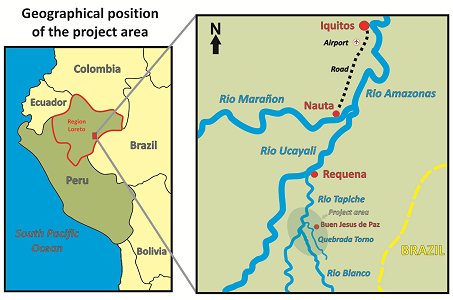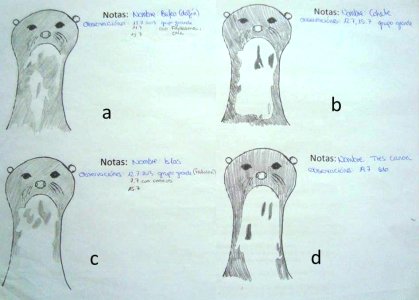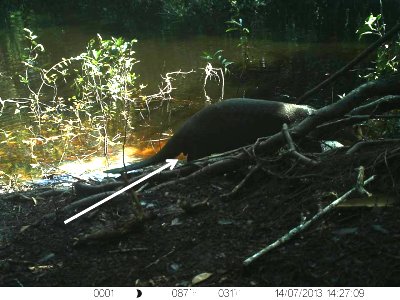IUCN/SSC Otter Specialist Group Bulletin

|
©IUCN/SCC Otter Specialist Group Volume 31 Issue 1 (January 2014) Citation: Tramm, I. (2014).Presence of Giant Otters (Pteronura brasiliensis) in the Río Torno in Northern Peru. IUCN Otter Spec. Group Bull. 31 (1): 49 - 54 Presence of Giant Otters (Pteronura brasiliensis) in the Río Torno in Northern Peru Ilka Tramm1 1Lornsenstr. 24, 24105 Kiel, Germany. Email: IlkaTramm@gmx.de |
 |
| Received 23rd January 2014, accepted 11th May 2014 |
| Abstract: Listed as endangered by the IUCN Red List the importance of monitoring and assessing viable populations of Giant Otters (Pteronura brasiliensis) is at its top. A small area near the river Tapiche in the northeast of Peru was investigated for the occurrence of Giant Otters. Local people supported the project as field assistants. Otters were seen on 13 occasions and 8 individuals could be identified by their individual throat pattern and the locations of dens were marked in a map. This study confirms the occurrence of giant otters in the Torno area and highlights the importance of conservation efforts in this area. |
| Keywords: Peruvian Amazon, Peru, throat pattern, individual identification |
| Française | Español |
INTRODUCTION
The Amazon Basin is one of the last places where giant otters are known to inhabit (Norris and Michalski, 2009). Giant otters live in social groups that range between 3-16 individuals, but it also varies with region, habitat and season (Carter and Rosas, 1997; Duplaix, 1980).
Giant Otters are classified as endangered according to the IUCN red list of threatened species and it is crucial to investigate and monitor the populations in the wild (Duplaix et al., 2008). The main threats for the survival of the species are habitat destruction, hunting and water pollution (Duplaix et al., 2008).
Giant otters can be identified individually by the cream coloured pattern on their throat (
Carter and Rosas, 1997
) serving as basis to produce an ID-kit of the group members. Recognizing individuals is essential when monitoring populations and investigating family constellations over time.
Pickles et al. (2011)
evaluated the use of camera traps in monitoring Giant Otter populations and found it was a useful tool to complement the observations by researchers regarding sexing the otters as well as determining activity patterns. Yet the conservation conflicts surrounding the giant otter (
Duplaix et al., 2008
) mean that population monitoring in isolation from the socio-economic context will be of little use for the conservation of this endangered species.
Previous studies show how education of the local population is as important as acute conservation efforts for the long-term conservation of giant otters (
Norris and Michalski, 2009
;
Michalski et al. 2012
;
Staib and Schenck 1994
). Much of our understanding of the conservation challenges and solutions for giant otters comes from pioneering work in the Peruvian Amazon (e.g.
Staib and Schenck 1994
;
Groenendijk and Hajek 2004
). These studies show how there is no general conservation solution for giant otters and that conservation actions need to be developed and refined to fit with the local situation. In Peru the non-governmental organization “Chances for Nature” is supporting a small village in a remote area of the Peruvian rainforest to both protect the local biodiversity and develop sources of sustainable income for the local people.
The objective of this work was to investigate the presents of giant otters (Pteronura brasiliensis) in this area to support the NGO “Chances for Nature” for their conservation concession.
STUDY AREA AND METHODS
The Tapiche River is a tributary of the Ucayali River in the northeast of Peru near the Pacaya-Samiria National Park and around 120km south of the city of Iquitos.
The Torno is a small black water river and side arm of the white water Tapiche River. It is situated in the northeast of the Peruvian rainforest, south of the city of Iquitos and Requena (Fig. 1). The vegetation is rich with a high number of plant species i.e. Astrocaryum chambira, Astrocaryum jauari, Mauritia flexuosa.
The presence of Giant Otters was investigated for 10 days in July 2013 in the Torno area near a small community called Villa Buen Jesus de Paz (5°32’59.2” S, 73°50’32.7” W; Fig. 1)
 |
| Figure 1. Project area at the Torno River. (click for larger version) |
On 8 days a small wooden canoe with a paddle was used to look for the otters. On two days additionally to the paddle a motor was utilized to look for otters further along the river. It was only looked for otters between 7 am and 2 pm. A stop-at-first-sign approach as recommended by Groenendijk and Hajek (2004) where every sign of otter presence is noted was applied. When giant otters were seen, photos were taken with a Nikon D3100. The GPS (Garmin GPS e Trex) coordinates were noted as well as the time of day and the number of otters observed. Indirect signs of otter presence (i.e. dens, campsites with spraints and tracks) were also marked in the GPS. A local villager assisted with the canoe and to locate the otters.
The throat patterns were transferred into a mask sheet on which also the date and which otters were seen together were noted.
A camera trap (Maginon WK 1) was put up at two different times at one den and recorded for four and eight days, respectively. It was set to take three pictures and a video sequence of 10 seconds each time it was triggered. The interval between the photos was set to 3 seconds. As recommended by Utreras and Pinos (2003) the camera trap was set up at approximately 50cm above the ground.
The website www.geoplaner.com was used to visualize the GPS coordinates in a map.
Results
Otters were seen on 13 occasions. Seven dens and five campsites along the river and oxbow lakes were marked in the GPS in a total of approximately 30km (Fig. 2). Based on the photos of the throat patterns 8 individuals could be identified, which were named according to the shape of the pattern (Fig. 3). Twice a group of about 8 otters was seen, but no throat pattern was completely visible. Juveniles were also present in this large group and some group members were also seen pairwise on some occasions.
 |
| Figure 2. GPS locations of Villa Buen Jesus de Paz (A) otter sightings (B), indirect signs (C). (click for larger version) |
A single adult was seen (Fig. 3.d) and cubs inside a den were heard on one occasion.
The camera trap reveals activity of the otters in the afternoon between 1:00pm-4:30pm (33 photos, 11 records). It also shows that the den was not visited every day, but with two days in between. The footage shows only one individual at a time, which prevents a proposition about group affiliation. No throat pattern could be identified, but one picture shows a male otter (Fig 4; identified by Dr. N. Duplaix Fig. 3). Local villagers reported the presence of giant otters along the Rio Blanco, a tributary of the Rio Torno (Fig. 1).
DISCUSSION
Since the species was classified as endangered in 2000 by the IUCN (Duplaix et al., 2008) it is even more important to undertake investigations of every viable population throughout South America. It is estimated that between 1000- 5000 Giant Otters exist in the wild (Duplaix et al., 2008). This study confirms the presence of at least one group of giant otters in the Torno area. The presence of different ages in the group indicates that the population is reproducing.
The sightings of pairs of otters which actually belong to a bigger group are supported by Rosas and de Mattos (2003). They reported subdivisions of family groups during foraging or escaping. Due to the sinking water level the otters used shortcuts over land to hide from the canoe. This may explain why some otters were seen in pairs which later showed up in the big group.
Pickles et al. (2011) argue that camera traps are a useful tool for supplementing observations made by researchers. Since no throat pattern was visible on the photos of the camera trap it may be useful putting up at least two camera traps at one location at different angles to increase the range of the camera and the possibility to get pictures of the throat sex. Carter and Rosas (1997) recommend sustainable development projects and appropriately located protected areas to ensure the survival of the species. The identification of 8 individuals is a start to a long term monitoring project, which is planned to be carried out by the local villagers over the next years. The understanding of the local people for the importance of the study was limited, which supports the finding of Michalski et al. (2012) that education and the involvement of the local people from the beginning of a project is very important.
This study was one of the first projects in this area and the villagers are gradually becoming more and more involved in assisting the researchers and students. The inhabitants of the village formed their own organization called “Los Iwatzu” with motive to protect the area around their village including the rivers Tapiche and Torno. This study confirms the occurrence of giant otter in the Torno area and highlights the importance of conservation efforts in this area.
Acknowledgements - I would like to thank “Chances for Nature” e.V., Dr. Christian Matauschek and Dr. Dirk Meyer for enabling this project, help and support, the people of Buen Jesus and Dr. Manolo Martin for their support and hospitality. I also thank Dr. Juan Valqui, Dr. Nicole Duplaix and one anonymous referee for valuable comments.
REFERENCES
Carter, S.K., Rosas, F. C. W. (1997). Biology and conservation of the Giant Otter Pteronura brasiliensis. Mammal Rev, 27: 1-26.
Duplaix, N. (1980). Observations on the Ecology and Behavior of the Giant River Otter Pteronura brasiliensis in Suriname.Revue d’Ecologie (La Terre et La Vie) 34: 495-620
Duplaix, N., Waldemarin, H.F., Groenedijk, J., Evangelista, E., Munis, M., Valesco, M. and Botello, J.C. (2008). Pteronura brasiliensis. In: IUCN 2013. IUCN Red List of Threatened Species. Version 2013. 1. [www.iucnredlist.org. Downloaded on 27 October 2013]
Groenendijk, J., Hajek, F. (2004). Giant Otter Project in Peru Field Trip and Activity Report-2003, IUCN Otter Spec. Group Bull., 21: 1-6.
Macdonald, S. (1990). Surveys In: Foster-Turley, P., Macdonald, S., Mason, C. (Eds.). Otters - An Action Plan for their Conservation, IUCN Otter Spec. Group, pp. 8-10.
Michalski F., Conceição, P.C., Amador, J.A., Laufer, J., Norris, D. (2012). Local Perceptions and Implications for Giant Otter (Pteronura brasiliensis) Conservation around Protected Areas in the Eastern Brazilian Amazon, IUCN Otter Spec. Group Bull., 29:34-45.
Norris, D., Michalski, F.,( 2009). Are Otters an Effective Flagship for the Conservation of Riparian Corridors in an Amazon Deforestation Frontier? IUCN Otter Spec. Group Bull., 26:73-77.
Pickles, R., Zambrana, V., Jordan, B., Hoffmann-Heap, I., Salinas, A., Groombridge,J., van Damme, P., (2011). An Evaluation of the Utility of Camera Traps in Monitoring Giant Otter Populations, IUCN Otter Spec. Group Bull., 28: 39-45.
Rosas, F. W., de Mattos, G.E. (2003). Notes on Giant Otter (Pteronura brasiliensis) Behavior in the Lake of the Balbina Hydroelectric Power Station, Amazonas, Brazil, Lat Am J Aquat Mammals, 2: 127-129.
Staib, E., Schenck, C. (1994). Giant Otters and Ecotourism in Peru, IUCN Otter Spec. Group Bull., 9: 3-4.
Utreras, V., Pinos, L., (2003). Camera Trap Use for Studying Giant Otters (Pteronura brasiliensis) in the Yasuní Biosphere Reserve, Ecuadorian Amazon, IUCN Otter Spec. Group Bull., 20: 69-71.
Résumé : Présence de Loutres Géantes (Pteronura Brasiliensis) au Río Torno dans le Nord-Est du Pérou
Il est de la plus haute importance que les populations viables de loutres géantes (Pteronura brasiliensis), considérées “en danger” dans la liste rouge de l’UICN, fassent l’objet d’une évaluation et d'un suivi. Une petite zone près de la rivière Tapiche dans le Nord-Est du Pérou a été étudiée dans le but d’y recenser les loutres géantes. Pour ce faire, des assistants ont été choisis parmi la population locale. Des loutres ont été vues à 13 occasions. 8 individus ont pu être identifiés par les marques spécifiques de leur gorge et les emplacements de leurs tanières ont été notifiés sur une carte. Cette étude confirme donc la présence de la loutre géante dans la région de Torno, et souligne l’importance des efforts de conservation dans cette zone.
Revenez au dessus
Resumen: Presencia de Nutrias Gigantes (Pteronura Brasiliensis) en el Río Torno, Norte del Perú
Listada como en peligro de extinción por la Lista Roja de la UICN, la importancia de monitorear y evaluar las poblaciones viables de Nutria Gigante (Pteronura brasiliensis ) es altísima. Investigamos una pequeña área en el río Tapiche, nordeste de Perú, buscando Nutria Gigante. La gente local apoyó el proyecto como asistentes de campo. Fueron vistas nutrias en 13 ocasiones, y pudimos identificar 8 individuos por su patrón individual de coloración de garganta, y las localizaciones de las madrigueras fueron marcadas en un mapa. Este estudio confirma la ocurrencia de las nutrias gigante en el área de Torno, y resalta la importancia de los esfuerzos de conservación en esta área.
Vuelva a la tapa

